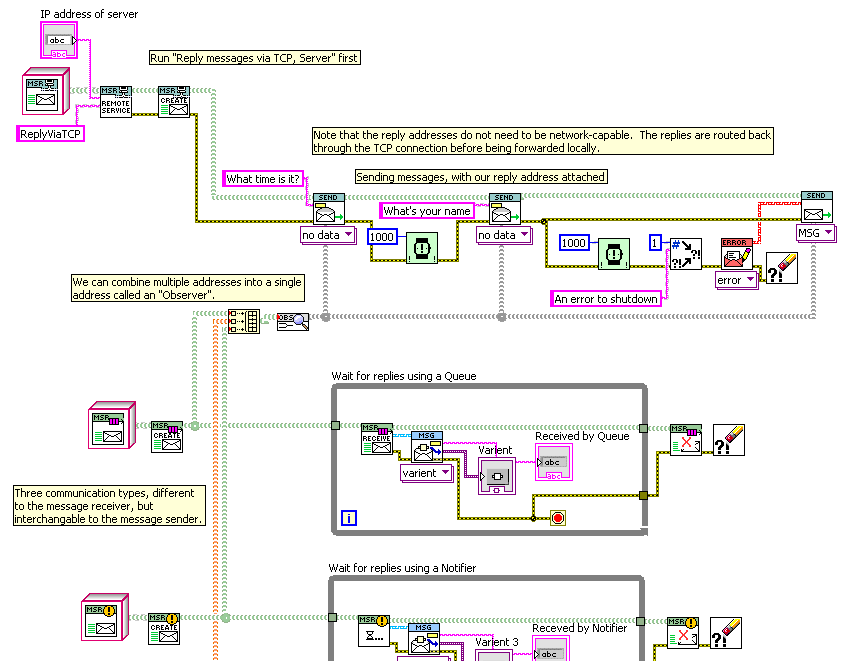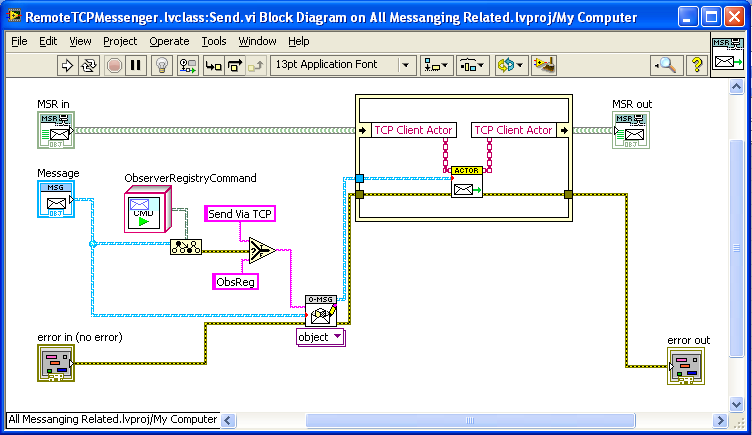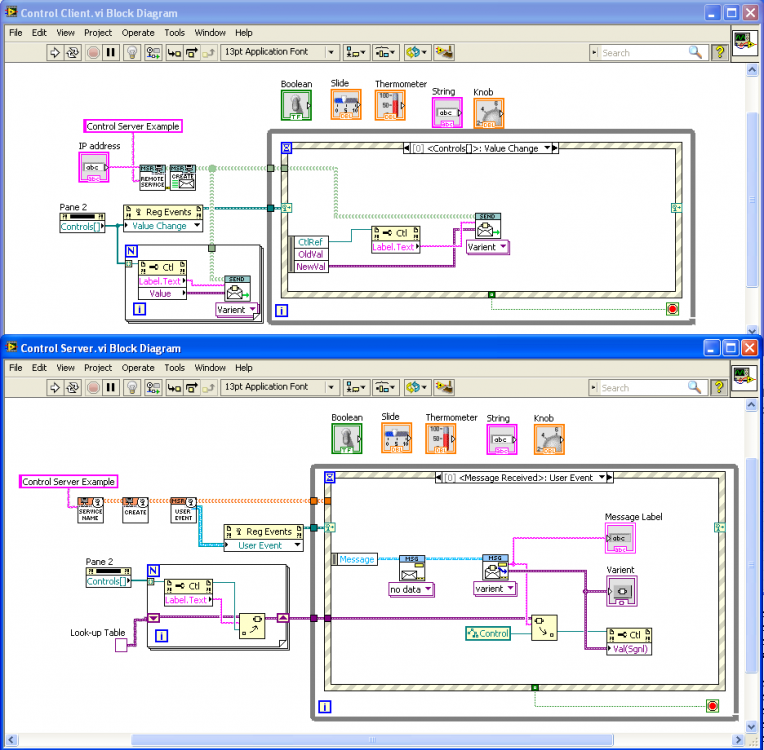-
Posts
1,986 -
Joined
-
Last visited
-
Days Won
183
Content Type
Profiles
Forums
Downloads
Gallery
Everything posted by drjdpowell
-
Do you have a four-core machine? I ask because then four clones will initially be reserved of the various shared-clones at start, and then the fifth instance will require a new clone. In working with shared clone pools (through an 0x40 reference to "Open VI Ref”) I have sometimes noticed what seems to be a delay in getting that extra clone when it is asked for soon after the reference is opened. BUT, I have never seen this delay actually stop code from working.
-
Are you overriding “Pre-launch Init.vi” such that it might produce an error (thus preventing the sending of the enqueuer back to the Launch VI)?
-

Lapdog over the network?
drjdpowell replied to GregSands's topic in Application Design & Architecture
You supply a reply address, and its optional. And the reply address does not have to be the sender’s; replies can be directed to any third party that the sender has the address of. -

Lapdog over the network?
drjdpowell replied to GregSands's topic in Application Design & Architecture
Ah yes, each message contains a reply address of “Send” class. So messages depend on “Send”, but not (I think) on any of the child classes of “Send”. -

Lapdog over the network?
drjdpowell replied to GregSands's topic in Application Design & Architecture
How would you do it? (Though you can explain what you mean be the Inverted dependency thing also.) -

Lapdog over the network?
drjdpowell replied to GregSands's topic in Application Design & Architecture
Well, the methods that send messages meant for the “TCP Client Actor” are dynamic-dispatch overrides of “Create” and “Destroy”. The only extra API method that RemoteTCPMesenger adds to the standard Messenger API is “Remote Service”, which is called first to define the IP address and service name to connect to. But I’ve lost the chain of thought. Remember, I need RemoteTCPMessenger to work in an extensive body of code that works with the generic “Send” and “Messenger” classes, thus I need to have it work through a predefined simple API (Create, Send, etc.), not some new TCP-specific API. Large parts of the codebase must be blind to the fact that it is using TCP. If the internals of RemoteTCPMessenger need to be slightly unclear to achieve this, that is no big problem, as the user of the messaging package doesn’t need to know this internal detail. Could you expand further? I send messages to an address, after someone has created the address; which I think is the same as how Lapdog does it. Here, BTW, is an example I’m going to add to the next version: A TCP client that communicates by request-reply with a server, and receives the messages back (for demonstration) in three different ways (by queue, User Event, or Notifier). The only TCP-specific API method is the “Remote Service” VI called first. -

What so bad about 'thread safe' singletons anyway?
drjdpowell replied to viSci's topic in Application Design & Architecture
If I recall the quote right, it’s the singletons you think you made thread safe that particularly inspire God’s wrath. Presumably because you actually didn’t. -

Lapdog over the network?
drjdpowell replied to GregSands's topic in Application Design & Architecture
Shaun, I think Daklu is referring to the need to register on your site in order to download the example. I just tried a test of attaching a VIPM package to this post and “This upload failed”, so perhaps the issue is with LAVA. BTW, here is the presentation slides Daklu is referring to (it’s on the CLA group at NI.com, but that group is restricted): CLA Summit 2013 Final.pptx In hindsight, I think it was too technical; I should have focused more on the “what” then the “how”. -

Lapdog over the network?
drjdpowell replied to GregSands's topic in Application Design & Architecture
It would be Address.Send if I were doing it today. “Send” is anything to which I can send a message. It’s a bit confusing because it is more general than a communication method like a queue (such methods are under the subclass “Messenger”). No, I’m actually going for 100% transparent TCP communication. Having message-sending code by able to work with any transport method was the original motivation of my messaging system. Whether that is really achievable with the intricacies of TCP I’m not sure, as I have not had a TCP project to work on in years. But there is no “SendButDontForward” message. Well, part of my philosophy is to have simple subcomponents whose messaging interaction is configured by higher-level components. So the subcomponent still needs to be provided a simple “address” to “send” to, even if the higher-level component knows that “address” as a more complex object with extra methods. Edit: Forgot to add: RemoteTCPMessenger is intended to either BE a network proxy, or be the Messenger inside a network proxy. -

Lapdog over the network?
drjdpowell replied to GregSands's topic in Application Design & Architecture
The technique of overriding a “Send” method can be used in multiple different ways. PrefixQueue might not be the most closely-related example. Well, as an example, here is the “Send” override method of my “RemoteTCPMessenger” class: As you can see, RemoteTCPMessenger wraps and sends messages to a TCP Client Actor. Other methods of RemoteTCPMessenger can send alternate messages to TCP Client to control it. Could I send the TCP messages directly and skip the actor? Well, in this case I have to route message replies and published event messages back through the TCP connection and thus need some process listening on that. Once I have to have the client actor anyway, it is cleaner and simpler to let it handle all aspects of the TCP connection. A TCP connection is too complex a thing to be left to a passive object. -

Lapdog over the network?
drjdpowell replied to GregSands's topic in Application Design & Architecture
It WAS POOPy! I was protecting you. -

Lapdog over the network?
drjdpowell replied to GregSands's topic in Application Design & Architecture
Opps. Sorry, I missed that. Not if you have a dynamic-dispatched “Send” method, in which case the wrapping of the original message in the SendViaTCP message can be inside the Send method. It’s the same technique you’re using in your LapDog PrefixQueue, where the sending process is unaware that the messages it is sending are having a prefix added. Similarly, a process doesn’t have to know it is sending messages via TCP. This isn’t really what I’m thinking of. “Outer Envelope” suggests a message holding another message. I don’t see why the inner message need be empty (an unfilled “inner envelope”). — James -

Lapdog over the network?
drjdpowell replied to GregSands's topic in Application Design & Architecture
He’s actually using what I call “Outer Envelopes”. You didn’t like them when I suggested them before. In fact, I use a “Send Via TCP” outer envelope in my TCP message system. -

Lapdog over the network?
drjdpowell replied to GregSands's topic in Application Design & Architecture
But would it not be easier to refactor in TCP communication if the extra added processes of TCP send/receive don’t have to be custom created to handle specific messages. And if my end processes are “X” and “UI for X”, how useful is it to have three intermediate message-handling stages? Surely at least one of that long message chain doesn’t need to know what an “Enable Motor” message means? -

Why are LVOOP classes not specified in G?
drjdpowell replied to jzoller's topic in Object-Oriented Programming
How do you distinguish language from meta-language if both are text? -
If it’s in a standard LabVIEW install then you can use it. I used the QMH template, if I recall.
-

Use of In place Structure outside a LabVIEW Class
drjdpowell replied to Naity's topic in Object-Oriented Programming
JamesMc86 is suggesting the possibility of writing a by-val class and allowing the application level to decide on DVR use (or not). The other options are writing a class API that takes DVRs as you’re doing, or use DVRs internal to the class (as todd mentions). If one is doing a class API that takes DVRs, then I agree you probably want to restrict use of the IPE to within that API. -
Some random thoughts: 1) I tend not to have an actual “UI actor”; instead I have each actor have it’s own UI on its front panel, and have the main actor present the subactors in one or more subpanels (or just open their windows. This involves less messages to pass around. 2) One can also deal with needing lots of messages for lots of UI controls by treating the controls generically using techniques illustrated below. This is a “Control Server” example that I don’t think is in the version of “Messenging” in the code repository, but will be in the next version. Changing any control in Pane 2 of the “Control Client” sends a Variant Message that then fires a Value Change event in the Control Server. You can do the same thing with “Notify”, and you can also write generic code for setting cluster items using OpenG functions. Would this kind of stuff help reduce the programming burden? 3) The above technique in (2) is event driven (User pushes button —> sends message —> fires Value Changed event). In contrast, using a DVR requires the receiver to poll for changes to the UI settings it cares about. It also works remotely (the example above works over TCP), though that is often not needed.
-
You mention “actors”, but one of the main points of the Actor Model is to use message passing instead of sharing by-reference data. So why not just send update messages when the User changes something?
-

Is there a document that describes XControl Facade events in detail?
drjdpowell replied to Mike Le's topic in User Interface
Unfortunately it’s on the restricted CLA group, but here is a very interesting presentation on XControls: Round Table Discussion - XControls -
It’s supposed to work with enums, and my test case seems to work. "Variant to JSON" delegates enums to OpenG’s “Scan from String” which calls OpenG “Set Enum String Value”, so it should work. What error did you get and what enum string did it have?
-

parent class wants to be saved after creating child
drjdpowell replied to John Lokanis's topic in Object-Oriented Programming
Have you tried recreating the parent “Execute” message from scratch? -

Question about using Semaphores with Actors
drjdpowell replied to Mike Le's topic in LabVIEW General
Yes. It shouldn’t matter how deep in the call chain the reference is created. BTW, what is the semaphore for? -
I’m sort of A, but the large amount of C involved makes me consider B. Thus: D.
-
XControls? A) Yes B) No C) <Head banging against wall> Thump…Thump…Thump... D) All of the above





